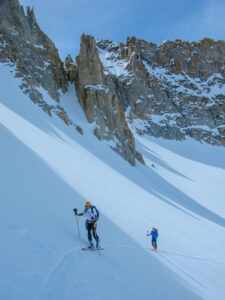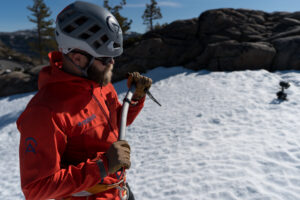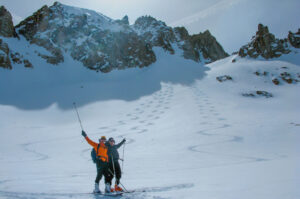Three Steps to Start Ski Mountaineering

What does it mean to be a ski mountaineer?
By definition, a ski mountaineer is someone who climbs mountains, either on skis or while carrying them, and then descends on skis. While the skills, techniques, and gear used to reach the start of one’s ski descent will vary between objectives, any scenario where mountaineering skills are required to deal with a distinct fall hazard in steep, glaciated, or otherwise technical terrain falls under the category of ski mountaineering (or skimo, for short).
Dropping into the world of ski mountaineering requires a diverse set of skills and competencies in order to effectively mitigate risk and objective hazard. As a result, the barrier to entry may appear insurmountable even to the expert resort skier. However, with a methodical approach, access to an experienced mentor or a certified guide, and a location that offers increasingly technical and/or challenging objectives, it is possible to go from low-angle backcountry tours to rappelling into a steep couloir and jump-turning your way down 5,000 vertical feet of untouched terrain.
Here, we’ve put together a brief how-to, as well as recommended first ventures, for those who are eager to learn basic skimo fundamentals and take their backcountry skills to steeper, higher, more exposed lines.
Develop the Skills of a Competent and Experienced Backcountry Skier

In order to competently navigate technical terrain as a backcountry skier, an expert level of downhill movement is required. This means the ability to link turns and maintain control while skiing a variety of terrain and snow conditions. Skiers should be confident in no-fall zones and heavily-gladed or featured areas. In the resort, this is comparable to confidence on ungroomed black diamond and double black diamond runs in all snow and/or weather conditions.
Beyond skiing ability, the competent and experienced backcountry skier knows how to identify and develop a plan for traveling in avalanche terrain using a combination of maps, weather, forecasts, snow science, and terrain clues to effectively mitigate risk. He or she must also be able to perform an effective companion rescue in the event of a burial. This knowledge is best gained by taking courses through the American Institute of Avalanche Research and Education (AIARE), which offers a series of avalanche education courses that build upon one another to gain an increased understanding of safe backcountry travel. For more information, see our AIARE 1 Hybrid Avalanche Course overview.
Backcountry knowledge must then be bolstered by extensive backcountry travel experience. For reference, the competent and experienced backcountry traveler is typically in the backcountry roughly 20+ days per season over multiple seasons in varying conditions. If you’re looking to get out in the backcountry and put days under your belt, check out our page on Private Ski Guiding.
Gain Basic Mountaineering Education and Experience
Much like backcountry skiing, the first step to gaining basic mountaineering skills often requires the supervision and instruction of a mentor or certified guide, as well as an understanding of the technical gear needed such as crampons, ice axes, rope systems, and belay practices.
At a minimum, the proficient mountaineer knows how to:
a) recognize hazards and plan a route using maps, forecasts, and terrain clues
b) use equipment such as crampons and ice axes to move over steep snow and ice
c) properly self-arrest in the event of a fall
 Additionally, mountaineering almost always requires efficient teamwork, especially when traveling as a roped team and/or in the event of a crevasse rescue scenario. It is paramount to safety and success in the mountains that climbers have these skills dialed before using them to take on bigger and bolder objectives common in ski mountaineering. As such, practicing your technical skills in low- or non-hazard environments with a group is by far the most effective way to hone your skill set.
Additionally, mountaineering almost always requires efficient teamwork, especially when traveling as a roped team and/or in the event of a crevasse rescue scenario. It is paramount to safety and success in the mountains that climbers have these skills dialed before using them to take on bigger and bolder objectives common in ski mountaineering. As such, practicing your technical skills in low- or non-hazard environments with a group is by far the most effective way to hone your skill set.
Depending on your objective, ski mountaineering may also require technical rock climbing skills, ice climbing skills, overnight camping, and experience at high altitudes. If you don’t have access to an experienced mentor, consider enrolling in our dual Intro to Mountaineering and Glacier Travel and Crevasse Rescue courses. Though these can be taken individually, we strongly recommend taking them back-to-back in a weekend (or otherwise in close proximity to one another), as these fundamentals build upon one another in a progressive, hands-on learning experience. For more information on basic mountaineering fundamentals as well as our courses, check out our blog: “Mountaineering Basics You Can Learn in Two Days”.
Set a Reachable Goal and Take Your Skills to the Mountains
Starting small and setting progressive goals that are within your reach is the best way to safely gain experience and understand how to effectively mitigate risk presented by the terrain and conditions. Below, we’ve provided a list of three beginner/intermediate ski mountaineering objectives as recommended by IFMGA-certified mountain guide Logan Talbott, co-owner and Chief Guide at Alpenglow Expeditions.
 **The recommended season for all three lines is late Winter to mid-Spring, depending on the snow conditions.
**The recommended season for all three lines is late Winter to mid-Spring, depending on the snow conditions.
Name: Mt. Gilbert
Location: South Lake Tahoe
Elevation Gain: Between 3,500-4,000 ft
Aspect: East-facing
Required Kit: At a minimum, a full ski touring setup with ski crampons are required for the ascent, and boot crampons may be needed depending on the conditions.
Name: The Coke Chute
Location: Mt. Dana/Dana Plateau, Lee Vining area
Elevation Gain: Roughly 4,000 ft.
Aspect: East-facing
Required Kit: A full touring setup with ski crampons as well as boot crampons are required for the ascent.
Name: Basin Peak
Location: Eastern Sierra near Bishop, CA
Elevation Gain: Roughly 5,500 ft.
Aspect: West-facing
Required Kit: A full touring setup with ski crampons as well as boot crampons are required for the ascent. Some rock scrambling may also be required.
As always, the best way to push your boundaries and gain new skills is to go with an experienced mentor or a certified guide. The final step of our Backcountry course series is the Backcountry 3.0: Intro to Ski Mountaineering. In this course, you will learn the basics of ski mountaineering, including steep skiing techniques, basic snow climbing, using an ice axe and crampons, basic rope techniques for steep ground and glacial travel, and use of ski crampons.
This is a comprehensive learning opportunity that introduces all three steps outlined above in a single, one-day course. Note that this is an advanced-level course requiring that participants have either a minimum of 25+ days of backcountry experience, or have completed our Backcountry 1.0, Backcountry 2.0, and 5-10+ additional days of touring. Essentially, the BC 3.0 is the equivalent of our Intro to Mountaineering course for a skier.
For further questions about starting your ski mountaineering career, give us a call at 877-873-5376 or send an email to info@alpenglowexpeditions to chat with our staff.